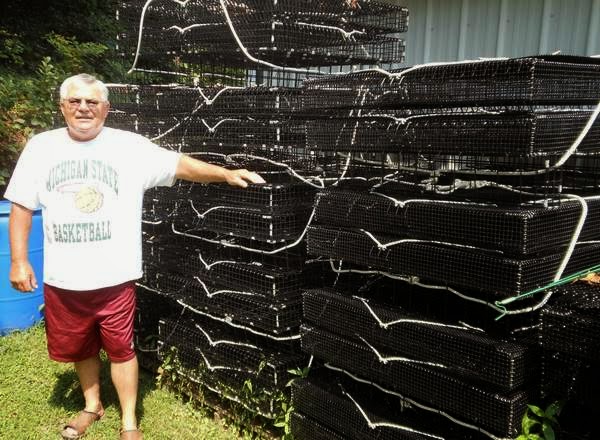Applications for shellfish aquaculture permits are to be accepted this fall by Delaware Department of Natural Resources and Environmental Control, reports Gape Gazette.
Steve Friend of Georgetown has already started getting ready, but “I just want to get it going, to get it started,” he said from his home while standing in front of a stack of 30 cages.
Though he is frustrated with how long the process has taken, he's is happy the regulations are finally ready.
Friend grew up in Lewes and has been raking clams since he was 10. The key to getting the clams, he said, is to tickle them out with the rake and estimates that on a good day, in four hours he can harvest 1800 clams.
He said he's looking forward to aquaculture because it will provide people with an opportunity to know where they're working on a day-to-day basis.
The process to create these regulations began in August 2013 creating a shellfish aquaculture industry in Delaware. The state was the last on the East Coast to adopt legislation establishing an aquaculture industry.
David Saveikis, DNREC Division of Fish and Wildlife director, stressed aquaculture is not a hobby and there are significant start-up costs associated with the new industry. He estimated that the first year could range from $15,000 to $30,000. Friend estimated he's already spent $25,000.
Chris Bason, Center for the Inland Bays executive director, was part of the group that helped the state develop its Shellfish Aquaculture Development Areas or SADAs.
In Rehoboth Bay, 260 acres in three locations have been set aside for aquaculture, representing 4.3 percent of the total bay area. In Indian River Bay, there are 125 acres in two locations, representing 1.36 percent of total bay area. In Little Assawoman Bay, there are 227 acres among four locations that represent 9.3 percent of total bay area.
Bason said the state generally adopted the areas as the team recommended, only slightly modifying some. He said overall, the areas have a low density of native hard clams and little recreational boat traffic.
“They're good, not perfect, but they're never perfect,” he said.
Minimum lease acreage is one acre, and the maximum any one applicant can apply for is five acres within Rehoboth and Indian River bays combined. An applicant who leases up to five acres in Rehoboth and/or Indian River bays may also lease an additional one to five acres in Little Assawoman Bay.
Friend said he's going to apply for five acres in Rehoboth and Little Assawoman bays.
The application fee for an aquaculture lease is $300. The annual fee for a lease is $100 an acre for a Delaware resident and $1,000 an acre for a nonresidents.
Initially farmers will be permitted to harvest the Eastern oyster in all three bays and hard clams in Little Assawoman Bay.
For a full list of the new shellfish aquaculture regulations, go to www.dnrec.delaware.gov.
Read more HERE.
Steve Friend of Georgetown has already started getting ready, but “I just want to get it going, to get it started,” he said from his home while standing in front of a stack of 30 cages.
Though he is frustrated with how long the process has taken, he's is happy the regulations are finally ready.
Friend grew up in Lewes and has been raking clams since he was 10. The key to getting the clams, he said, is to tickle them out with the rake and estimates that on a good day, in four hours he can harvest 1800 clams.
He said he's looking forward to aquaculture because it will provide people with an opportunity to know where they're working on a day-to-day basis.
The process to create these regulations began in August 2013 creating a shellfish aquaculture industry in Delaware. The state was the last on the East Coast to adopt legislation establishing an aquaculture industry.
David Saveikis, DNREC Division of Fish and Wildlife director, stressed aquaculture is not a hobby and there are significant start-up costs associated with the new industry. He estimated that the first year could range from $15,000 to $30,000. Friend estimated he's already spent $25,000.
Chris Bason, Center for the Inland Bays executive director, was part of the group that helped the state develop its Shellfish Aquaculture Development Areas or SADAs.
In Rehoboth Bay, 260 acres in three locations have been set aside for aquaculture, representing 4.3 percent of the total bay area. In Indian River Bay, there are 125 acres in two locations, representing 1.36 percent of total bay area. In Little Assawoman Bay, there are 227 acres among four locations that represent 9.3 percent of total bay area.
Bason said the state generally adopted the areas as the team recommended, only slightly modifying some. He said overall, the areas have a low density of native hard clams and little recreational boat traffic.
“They're good, not perfect, but they're never perfect,” he said.
Minimum lease acreage is one acre, and the maximum any one applicant can apply for is five acres within Rehoboth and Indian River bays combined. An applicant who leases up to five acres in Rehoboth and/or Indian River bays may also lease an additional one to five acres in Little Assawoman Bay.
Friend said he's going to apply for five acres in Rehoboth and Little Assawoman bays.
The application fee for an aquaculture lease is $300. The annual fee for a lease is $100 an acre for a Delaware resident and $1,000 an acre for a nonresidents.
Initially farmers will be permitted to harvest the Eastern oyster in all three bays and hard clams in Little Assawoman Bay.
For a full list of the new shellfish aquaculture regulations, go to www.dnrec.delaware.gov.
Read more HERE.
The Aquaculturists
This blog is maintained by The Aquaculturists staff and is supported by the
magazine International Aquafeed which is published by Perendale Publishers Ltd
For additional daily news from aquaculture around the world: aquacutlure-news
